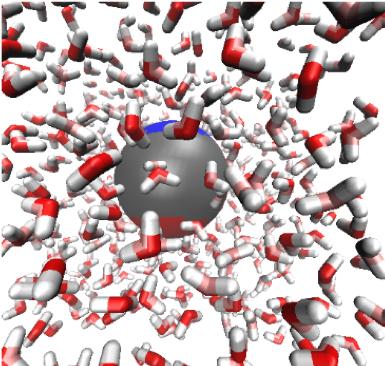THz spectroscopy could help Explain water's anomalies

Liquid water sustains life on earth, but its physical properties remain mysterious among scientific researchers. Recently, a team of Swiss researchers used existing THz spectroscopy techniques to measure liquid water's hydrogen bonding. Future efforts with this technique could one day help explain water's peculiar properties. The team reports their findings in The Journal of Chemical Physics. This image shows a Dipolar Lennard-Jones sphere solvated in water. Credit: Hamm
Liquid water sustains life on earth, but its physical properties remain mysterious among scientific researchers. Recently, a team of Swiss researchers used existing THz spectroscopy techniques to measure liquid water's hydrogen bonding. Future efforts with this technique could one day help explain water's peculiar properties. The team reports their findings in The Journal of Chemical Physics, from AIP Publishing.
“What makes this paper special is the aspect of THz spectroscopy of a liquid. In the THz range, we make spectroscopy explicitly of the intermolecular degrees of freedom of the system in the study, to contrast it to intramolecular degrees of freedom,” said Peter Hamm, an author on the paper. “With THz spectroscopy, we can very directly look at the hydrogen bonding between various water molecules.”
Researchers use spectroscopy to measure the interaction of matter with light and infer something's physical composition. In this experiment, the researchers excited a dye molecule dissolved in water with an ultrashort visible laser pulse, changing its charge distribution. Then, a THz pulse measured the response of the surrounding water molecules as a function of the time after that excitation process.
THz spectroscopy, which is relatively low frequency, enables researchers to examine the forces that exist between water molecules. Observing these intermolecular forces could help researchers understand water's anomalies, because hydrogen bonding in liquid water molecules make up many of water's unexpected properties, like its unusual density maximum at 4 degrees Celsius.
“The response we found in the THz frequency range was surprisingly slow. Water is typically considered to be a very fast solvent with a response in the subpicosecond range, but we found a timescale around 10 picoseconds in the THz,” Hamm said. They attributed the slow timescale to the collective nature of the water response that was probed using THz spectroscopy.
Hamm clarified that researchers have been using THz spectroscopy for more than 20 years and cautioned optimism about the results. “The outcome often has been a bit disappointing because the THz spectra of liquids like water are extremely broad and blurred, and it's very hard to extract information out of that,” he said. Time-resolved techniques, like in this study, might overcome that limitation.
Next, the researchers plan to use their method to look at water's structure and dynamics when it's still liquid, but below the freezing point. Hamm explained, “The special properties of water become significantly more pronounced if one goes to temperatures below the freezing point.”
###
The article, “Aqueous solvation from the water perspective,” is authored by Saima Ahmed, Andrea Pasti, Ricardo J. Fernandez-Teran, Gustavo Ciardi, Andrey Shalit and Peter Hamm. The article appeared in The Journal of Chemical Physics June 19, 2018, (10.1063/1.5034225) and can be accessed at https:/
ABOUT THE JOURNAL
The Journal of Chemical Physics publishes concise and definitive reports of significant research in the methods and applications of chemical physics. See http://jcp.
Media Contact
More Information:
http://dx.doi.org/10.1063/1.5034225All latest news from the category: Life Sciences and Chemistry
Articles and reports from the Life Sciences and chemistry area deal with applied and basic research into modern biology, chemistry and human medicine.
Valuable information can be found on a range of life sciences fields including bacteriology, biochemistry, bionics, bioinformatics, biophysics, biotechnology, genetics, geobotany, human biology, marine biology, microbiology, molecular biology, cellular biology, zoology, bioinorganic chemistry, microchemistry and environmental chemistry.
Newest articles

NASA: Mystery of life’s handedness deepens
The mystery of why life uses molecules with specific orientations has deepened with a NASA-funded discovery that RNA — a key molecule thought to have potentially held the instructions for…

What are the effects of historic lithium mining on water quality?
Study reveals low levels of common contaminants but high levels of other elements in waters associated with an abandoned lithium mine. Lithium ore and mining waste from a historic lithium…

Quantum-inspired design boosts efficiency of heat-to-electricity conversion
Rice engineers take unconventional route to improving thermophotovoltaic systems. Researchers at Rice University have found a new way to improve a key element of thermophotovoltaic (TPV) systems, which convert heat…



